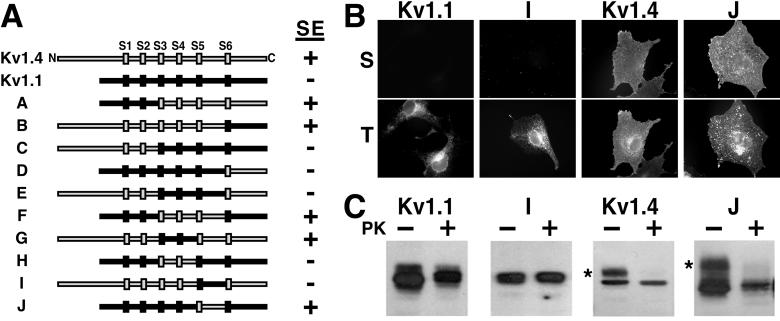Figure 1.
The P-domain regulates trafficking of Kv1 channels. (A) The Kv1 chimeras generated are as follows: A, Kv1.1N(1–253)–1.4C(405–654); B, Kv1.4N(1–542)–1.1C(390–495); C, Kv1.4N(1–404)–1.1C(254–495); D, Kv1.1N(1–389)–1.4C(543–654); E, Kv1.4N(1–404)–1.1(254–389)-1.4C(543–654); F, Kv1.1N(1–253)–1.4(405–542)-1.1C(390–495); G, Kv1.4N(1–404)–1.1(254–322)-1.4C(474–654); H, Kv1.1N(1–253)–1.4(405–474)-1.1C(322–495); I, Kv1.4N(1–474)–1.1(322–389)-1.4C(543–654); J, Kv1.1N(1–321)–1.4(475–542)-1.1C(390–495). SE values for Kv1 chimeras were determined: (+) = >85%, (−) = <3%, and (+/−) = 10–50% of cells express Kv1 channels on the cell surface. Chimeras I and J define the P-domain between transmembrane segments S5 and S6 as the trafficking determinant. (B) Subcellular localization of wild-type and chimeric Kv1 subunits. Chimeras I and J recapitulate the subcellular localization of wild-type Kv1.1 and Kv1.4 subunits, respectively. Kv1.1 and Chimera I accumulate in the ER, whereas Kv1.4 and Chimera J are present on the cell surface. S, surface staining with an ectodomain-directed antibody in the absence of detergent permeabilization; T, total staining with a cytoplasmic domain-directed antibody after detergent permeabilization. (C) Biochemical analysis reveals proteinase K (PK) cell-surface populations of Kv1.4 and Chimera J (asterisks) but not Kv1.1 or Chimera I.

